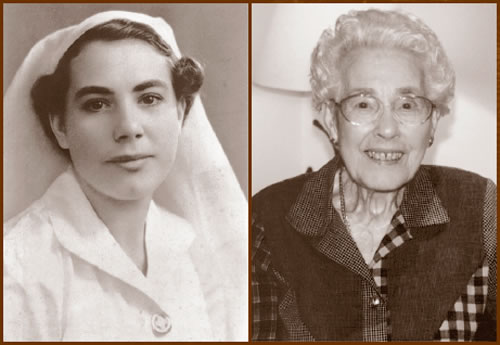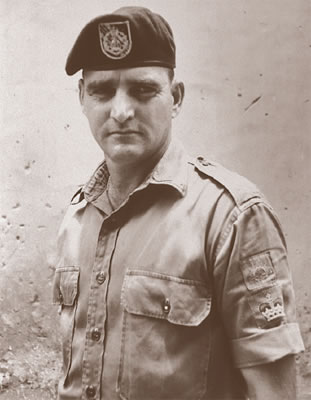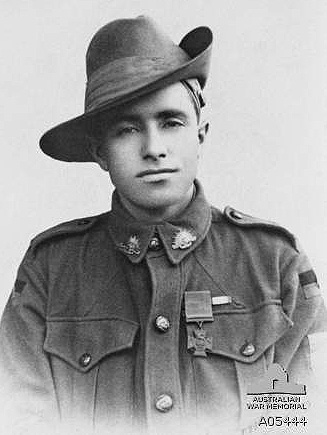PEACE GROVE Kit Kenneison, former Hospital gardener, at work on his sculpture. An emblem of peace, which was to become the memorial stone for the Peace Grove.
The Hall of Remembrance was opened at Greenslopes Private Hospital on Anzac Day 1995, as part of the Australia Remembers commemorations (1945 - 1995). The opening of the Hall marked the fulfilment of a pledge made to veterans to develop a memorabilia hall, by the owner-operator of the Hospital, Ramsay Health Care, when it took over the Hospital from the Federal Government in 1995.
The Hall houses a permanent display of hospital-related photographs and service memorabilia as well as displays marking special events and anniversaries on the veteran calendar.
CORPORAL JOHN FRENCH The hospital has now paid tribute to one of the many great war veterans and the first Queenslander to be awarded the Victorian Cross during World War II, naming the new 90 bed wing accommodation after Corporal John Alexander French.
Corporal French, born in Crow's Nest in 1914, was held up by fire from three enemy machine gun posts on 4 September, 1942 at Milne Bay, Papua, where he ordered the section to take cover, advanced and silenced the first two posts with grenades.
He then attacked the third post with a submachine gun, and although obviously badly wounded, continued to advance. The enemy guns ceased to fire and the section pushed on to find that all members of their crews had been killed and that Corporal French had died in front of the third gun.
The hospital has given recognise to Corporal French for his courageous action which enabled the section to complete its task, saving them from heavy causalities and responsible for the successful conclusion of the attack.
By the time the attack was over, more than 60 Japanese had been killed and a few days later, the Japanese resistance in the area collapsed. On 18 July, 1958, GG Sir William Slim, opened the French Memorial Library at Crow's Nest which was erected from funds raised by the proud townspeople.

Above: Corporal John Alexander French.
JESSIE VASEY The hospital has also named its multistorey wing after Jessie Vasey in recognition of her service as a champion of war widows via the War Widows Guild of Australia.
Herself a war widow, she fought for their rights and the story of the Guild is interwoven with that of a remarkable woman. Mrs Vasey gave the last 20 years of her life to the establishment and developed the Guild into the most powerful women's bloc Australia has known.
The building, which comprises of six floors, has been in existence since the early 1980s, but until now has been known as the Multistorey Wing. With several multistory buildings now being developed on our campus, this name is now redundant and, in line with our tradition and heritage, it is fitting that we name it after such an important war widow. We already have the Keith Payne Unit and the Florence Syer Unit on our campus.
FLORENCE SYER The Florence Syer Unit was opened at Greenslopes Private Hospital on 6 June 1999. The Unit is a 30 bed Sub-acute Unit accommodated in one of the last remaining wards of the former Greenslopes Repatriation Hospital, which has been renovated for this special purpose.
The Unit is intended for patients who are past the acute stage of their illness, but are not ready to go home; are awaiting hostel or nursing home placement; or have not the access to social support or carers.
Florence Syer was a 25 year old trained Brisbane General Hospital Army Nurse when she was called up in 1941 to care for Australian soldiers in Malacca Hospital in Singapore.
The Hospital was evacuated when the Japanese swooped down on the Malay Peninsula, but their escape ship was bombed at sea. Surviving the bombs and machine gun fire, Mrs Syer (then Miss Trotter) and four other nurses managed to hang on to a floating rail for 18 hours before being taken prisoner of war for a torturous three years and nine months. Many died in the camps from fever and malnutrition as the nurses were forced to migrate from one POW camp to another. "Food was always scarce, so we learned to be creative. Privet hedge and hibiscus leaves are quite tasty when made into a soup and a little rice!
There was another move on 1 April 1942. The men were separated from the women and marched off. We walked for hours in the heat, barefooted and without hats to protect us. Eventually, we reached some empty houses and were told to go in and wait. We were there for 18 months! The houses only had three rooms but there were at least 24 people in each house; a number, which increased as ever more people were brought into the camp..."
One of the small number of fortunate ones to survive this three and a half year ordeal, Mrs Syer returned to Australia in September 1945. She married in 1947 and had two daughters. Mrs Syer died in Greenslopes Private Hospital in July 2002 at the age of 86.
Greenslopes Private Hospital is proud to have named the Sub-acute Unit in her honour.

Above: Florence Syer.
KEITH PAYNE UNIT Prior to 1996, psychiatric inpatient services at Greenslopes were housed in one of the old pavilion ward blocks. In that year, Ramsay Health Care opened a modern, air-conditioned facility offering inpatient, outpatient, day-hospital services, and recreational areas.
Warrant Officer Keith Payne was, in 1969, a member of the Australian Army Training Team, Vietnam. On 24 May, the South Vietnamese battalion he commanded was attacked by a large force of North Vietnamese. Although wounded several times, Payne organised a fighting withdrawal and saved the lives of many of his men. In 1970, Her Majesty Queen Elizabeth presented WO Payne with the Victoria Cross aboard the Royal Yacht Britannia in Brisbane.

Above: WO Keith Payne, circa 1969.
HENRY DALZIEL Henry "Harry" Dalziel (1893-1965), from Queensland, received the second of two Victoria Crosses awarded for the battle of Hamel in northern France.
During the action he advanced with a Lewis gun section before making a single-handed attack on a strong enemy machine-gun post, capturing the gun and its entire crew. Then, ignoring heavy enemy fire, he collected ammunition and reloaded magazines until he was severely wounded.
King George V presented the Victoria Cross medal to Harry Dalziel at Buckingham Palace. After the war, although troubled by his injuries, he served in the militia and was also a songwriter. Harry Dalziel passed away at Greenslopes Hospital in 1965.
The Henry Dalziel VC Dialysis Centre was officially opened by the Federal Minister for Veterans’ Affairs, the Hon. Danna Vale MP, on 28 August 2003.

Above: Private Henry "Harry" Dalziel VC